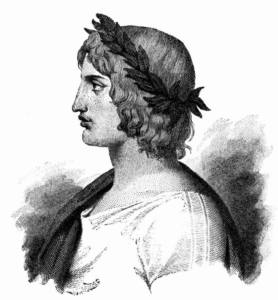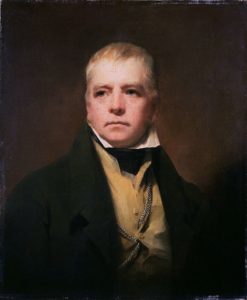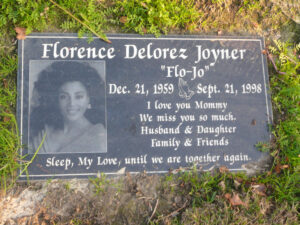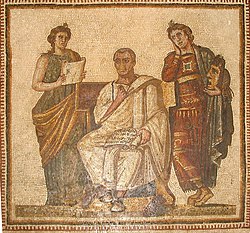 On this day in 19 BC, ancient Roman poet of the Augustan period, Virgil died in Brundisium harbor at the age of 50. Born Publius Vergilius Maro on October 15, 70 BC Near Mantua, Cisalpine Gaul, Roman Republic (now Province of Mantua, Italy). He wrote three of the most famous poems in Latin literature: the Eclogues (or Bucolics), the Georgics, and the epic Aeneid. A number of minor poems, collected in the Appendix Vergiliana, are sometimes attributed to him.
On this day in 19 BC, ancient Roman poet of the Augustan period, Virgil died in Brundisium harbor at the age of 50. Born Publius Vergilius Maro on October 15, 70 BC Near Mantua, Cisalpine Gaul, Roman Republic (now Province of Mantua, Italy). He wrote three of the most famous poems in Latin literature: the Eclogues (or Bucolics), the Georgics, and the epic Aeneid. A number of minor poems, collected in the Appendix Vergiliana, are sometimes attributed to him.
Virgil is traditionally ranked as one of Rome’s greatest poets. His Aeneid has been considered the national epic of ancient Rome since the time of its composition. Modeled after Homer‘s Iliad and Odyssey, the Aeneid follows the Trojan refugee Aeneas as he struggles to fulfill his destiny and reach Italy, where his descendants Romulus and Remus were to found the city of Rome. Virgil’s work has had wide and deep influence on Western literature, most notably Dante‘s Divine Comedy, in which Virgil appears as Dante’s guide through Hell and Purgatory.
The Final Footprint
The verse inscription at Virgil’s tomb was supposedly composed by the poet himself: Mantua me genuit, Calabri rapuere, tenet nunc Parthenope. Cecini pascua, rura, duces. (“Mantua gave me life, the Calabrians took it away, Naples holds me now; I sang of pastures, farms, and commanders.” [trans. Bernard Knox])
The structure known as “Virgil’s tomb” is found at the entrance of an ancient Roman tunnel (also known as “grotta vecchia”) in Piedigrotta, a district 3 kilometres (2 mi) from the centre of Naples, near the Mergellina harbor, on the road heading north along the coast to Pozzuoli. While Virgil was already the object of literary admiration and veneration before his death, in the Middle Ages his name became associated with miraculous powers, and for a couple of centuries his tomb was the destination of pilgrimages and veneration.
 On this day in 1832, Scottish novelist, playwright and poet, Sir Walter Scott died, under unexplained circumstances, at the age of 61 at his home Abbotsford House near Melrose in the Scottish borders. Scott was the first English-language author to have a truly international career in his lifetime, with many contemporary readers in Europe, Australia, and North America. His novels and poetry are still read, and many of his works remain classics of both English-language literature and of Scottish literature. His best known works include the novels, Ivanhoe, Rob Roy, Waverley, The Heart of Midlothian and The Bride of Lammermoor and his poem The Lady of the Lake. Scott married Charlotte Genevieve Charpentier (or Carpenter), daughter of Jean Charpentier of Lyon, France. Born on 15 August 1771 in College Wynd in the Old Town of Edinburgh.
On this day in 1832, Scottish novelist, playwright and poet, Sir Walter Scott died, under unexplained circumstances, at the age of 61 at his home Abbotsford House near Melrose in the Scottish borders. Scott was the first English-language author to have a truly international career in his lifetime, with many contemporary readers in Europe, Australia, and North America. His novels and poetry are still read, and many of his works remain classics of both English-language literature and of Scottish literature. His best known works include the novels, Ivanhoe, Rob Roy, Waverley, The Heart of Midlothian and The Bride of Lammermoor and his poem The Lady of the Lake. Scott married Charlotte Genevieve Charpentier (or Carpenter), daughter of Jean Charpentier of Lyon, France. Born on 15 August 1771 in College Wynd in the Old Town of Edinburgh.
 The Final Footprint – Scott is buried in a pillared side chapel of the Dryburgh Abbery ruins in Melrose. During his lifetime, Scott’s portrait was painted by Sir Edwin Landseer and fellow-Scots Sir Henry Raeburn and James Eckford Lauder. In Edinburgh, the 61.1 metre tall Victorian Gothic spire of the Scott Monument was designed by George Meikle Kemp. It was completed in 1844, 12 years after Scott’s death, and dominates the south side of Princes Street. Scott is also commemorated on a stone slab in Makars’ Court, outside The Writers’ Museum, Lawnmarket, Edinburgh, along with other prominent Scottish writers; quotes from his work are also visible on the Canongate Wall of the Scottish Parliament building in Holyrood. There is a tower dedicated to his memory on Corstorphine Hill in the west of the city and as mentioned previous Edinburgh’s Waverley railway station takes the name of one of his novels. In Glasgow, Walter Scott’s Monument dominates the centre of George Square, the main public square in the city. Designed by David Rhind in 1838, the monument features a large column topped by a statue of Scott. There is a statue of Scott in New York City’s Central Park. The annual Walter Scott Prize for Historical Fiction was created in 2010 by the Duke and Duchess of Buccleuch, whose ancestors were closely linked to Sir Walter Scott. At £25,000 it is one of the largest prizes in British literature. The award has been presented at Scott’s historic home Abbotsford House.
The Final Footprint – Scott is buried in a pillared side chapel of the Dryburgh Abbery ruins in Melrose. During his lifetime, Scott’s portrait was painted by Sir Edwin Landseer and fellow-Scots Sir Henry Raeburn and James Eckford Lauder. In Edinburgh, the 61.1 metre tall Victorian Gothic spire of the Scott Monument was designed by George Meikle Kemp. It was completed in 1844, 12 years after Scott’s death, and dominates the south side of Princes Street. Scott is also commemorated on a stone slab in Makars’ Court, outside The Writers’ Museum, Lawnmarket, Edinburgh, along with other prominent Scottish writers; quotes from his work are also visible on the Canongate Wall of the Scottish Parliament building in Holyrood. There is a tower dedicated to his memory on Corstorphine Hill in the west of the city and as mentioned previous Edinburgh’s Waverley railway station takes the name of one of his novels. In Glasgow, Walter Scott’s Monument dominates the centre of George Square, the main public square in the city. Designed by David Rhind in 1838, the monument features a large column topped by a statue of Scott. There is a statue of Scott in New York City’s Central Park. The annual Walter Scott Prize for Historical Fiction was created in 2010 by the Duke and Duchess of Buccleuch, whose ancestors were closely linked to Sir Walter Scott. At £25,000 it is one of the largest prizes in British literature. The award has been presented at Scott’s historic home Abbotsford House.
#RIP #OTD in 1860 philosopher (The World as Will and Representation, philosophical pessimism, hedgehog’s dilemma) Arthur Schopenhauer died of pulmonary-respiratory failure at home in Franfurt aged 72 Hauptfriedhof Frankfurt am Main, Frankfurt am Main, Germany
#RIP #OTD 1974 actress, novelist (Valley of the Dolls, The Love Machine, Once Is Not Enough) Jacqueline Susann died at Doctors Hospital, Manhattan from breast/lung cancer aged 56. Cremation
 On this day in 1998 track and field athlete, 3x Olympic gold medalist, 2x silver medalist, Flo-Jo, Florence Griffith Joyner died from an epileptic seizure at her home in Mission Viejo, California, age 38. Born Florence Delorez Griffith in Los Angeles on 21 December 1959.
On this day in 1998 track and field athlete, 3x Olympic gold medalist, 2x silver medalist, Flo-Jo, Florence Griffith Joyner died from an epileptic seizure at her home in Mission Viejo, California, age 38. Born Florence Delorez Griffith in Los Angeles on 21 December 1959.
She set world records in 1988 for the 100 m and 200 m. During the late 1980s she became a popular figure due to both her record-setting athleticism and eclectic personal style. She was athletic from a young age and began running at track meets as a child. While attending California State University, Northridge (CSUN) and University of California, Los Angeles (UCLA), she continued to compete in track and field. While still in college, she qualified for the 100 m 1980 Olympics, although she did not actually compete due to the U.S. boycott. She made her Olympic debut four years later, winning a silver medal in the 200 meter distance at the 1984 Olympics held in Los Angeles. At the 1988 U.S. Olympic trials, Griffith set a new world record in the 100 meter sprint. She went on to win three gold medals at the 1988 Olympics.
In February 1989, Griffith Joyner abruptly retired from athletics. She remained a pop culture figure through endorsement deals, acting, and designing.
Griffith’s nickname among family was “Dee Dee”. She was briefly engaged to hurdler Greg Foster. In 1987, Griffith married 1984 Olympic triple jump champion Al Joyner, whom Griffith had first met at the 1980 Olympic Trials. Through her marriage to Joyner she was sister-in-law to track and field athlete Jackie Joyner-Kersee.
 The Final Footprint – The unexpected death was investigated by the Orange County Sheriff-Coroner’s office, which announced on September 22 that the cause of death was suffocation during a severe epileptic seizure. Griffith Joyner was found to have had a cavernous hemangioma, a congenital vascular brain abnormality that made her subject to seizures. According to a family attorney, she had suffered a tonic-clonic seizure in 1990 and had been treated for seizures in 1993 and 1994. According to the Sheriff-Coroner’s office, the only drugs in her system when she died were small amounts of two common over-the-counter drugs, acetaminophen and the antihistamine Benadryl. El Toro Memorial Park in Lake Forest, California
The Final Footprint – The unexpected death was investigated by the Orange County Sheriff-Coroner’s office, which announced on September 22 that the cause of death was suffocation during a severe epileptic seizure. Griffith Joyner was found to have had a cavernous hemangioma, a congenital vascular brain abnormality that made her subject to seizures. According to a family attorney, she had suffered a tonic-clonic seizure in 1990 and had been treated for seizures in 1993 and 1994. According to the Sheriff-Coroner’s office, the only drugs in her system when she died were small amounts of two common over-the-counter drugs, acetaminophen and the antihistamine Benadryl. El Toro Memorial Park in Lake Forest, California
Have you planned yours yet?
Follow TFF on twitter @RIPTFF








Pingback: The Rover’s Adieu » TeaWithTater.com